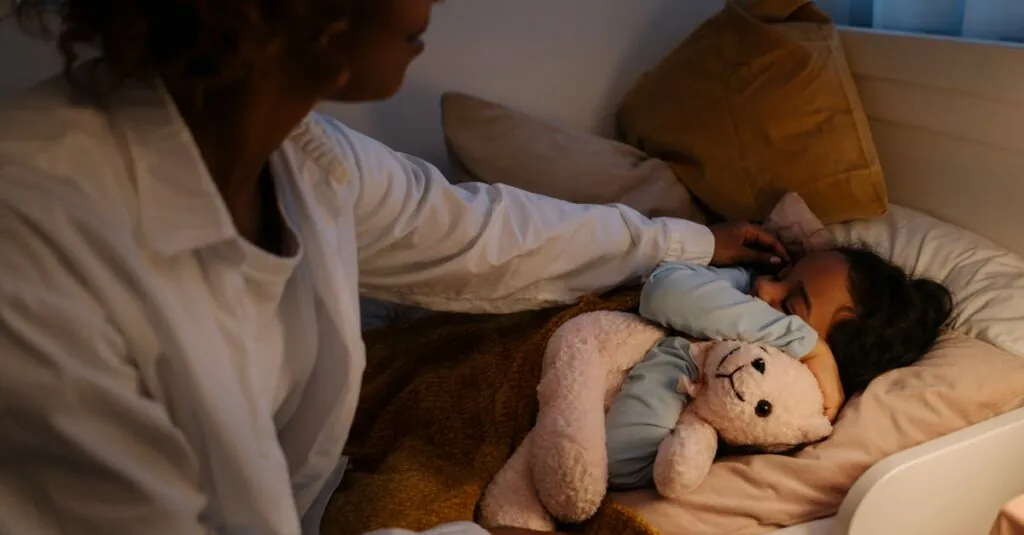Every parent knows the struggle of bedtime battles and the quest for the perfect sleep environment. But when it comes to pillows, the question looms large: when can kids finally join the pillow party? It’s a topic that mixes safety with comfort, and every parent wants to make the right call.
Table of Contents
ToggleUnderstanding Child Sleep Patterns
Understanding child sleep patterns is vital for parents when navigating bedtime decisions. Sleep needs vary by age, impacting how and when children use pillows.
Newborns and Sleep
Newborns typically sleep 14 to 17 hours a day. During the first few months, they need a firm, flat surface for safety. Pillows pose suffocation risks, hindering a newborn’s ability to breathe properly. The American Academy of Pediatrics recommends keeping the sleep environment free of soft bedding until the baby turns one. Maintaining a safe sleep space sets a foundation for healthy sleep habits.
Infants and Transitional Sleep Stages
Infants sleep around 12 to 16 hours daily, often experiencing transitional sleep stages. By six months, many infants develop the ability to roll over, which may affect pillow use. Introducing a small, flat pillow can provide comfort once a child exhibits sleep patterns that indicate readiness. Parents should consider the child’s head and neck support when deciding to add a pillow, always prioritizing safety and comfort.
Factors Influencing Pillow Use
Determining when kids can sleep with a pillow depends on several factors. Parents should consider age and safety aspects closely.
Age Recommendations
Most experts suggest introducing a pillow between the ages of 2 and 3. Enhanced head and neck support becomes crucial as children transition from cribs to beds. Parents often notice increased comfort when kids use a small, flat pillow during this time. The shift typically occurs as toddlers develop stronger neck muscles and better head control. By age 4, many children are ready for a standard pillow. Individual readiness can vary, so monitoring children’s sleep habits remains important.
Safety Considerations
Safety framing is vital when introducing pillows to young children. Soft bedding can elevate the risk of suffocation, particularly for infants under 12 months. The American Academy of Pediatrics emphasizes maintaining a safe sleep environment. When a pillow is introduced, minimizing the size and softness can reduce hazards. Parents should ensure that pillows offer adequate support without creating suffocation risks. Additionally, supervising children during sleep can help determine their comfort and safety levels.
Benefits of Using a Pillow
Using a pillow can significantly enhance a child’s sleep experience. Properly selected pillows offer benefits like improved comfort and support, leading to better sleep quality.
Comfort and Support
Comfort is crucial for restful sleep. A small, firm pillow provides necessary head and neck support, which helps align the spine. Transitioning from cribs to beds often requires this support. Children ages 2 to 3 particularly benefit from a pillow that eases the adjustment to a new sleeping environment. If pillows are introduced at the right time, children feel more secure and cozy, reducing restlessness during the night.
Improved Sleep Quality
Quality sleep positively affects a child’s mood and development. Pillows facilitate deeper sleep by reducing tossing and turning. Children often sleep longer and wake up less frequently when they experience comfort. Sleep quality can improve with the right pillow choice, encouraging uninterrupted rest. Happy and well-rested children tend to demonstrate better focus and increased energy throughout the day. Selecting an appropriate pillow relevant to their age can make a notable difference in their overall sleep experience.
When to Introduce a Pillow
Timing plays a crucial role in introducing a pillow to a child’s sleep routine. Factors include safety, comfort, and individual readiness.
Signs Your Child Is Ready
Indicators such as restlessness during sleep or finding comfort with a soft object suggest readiness for a pillow. If a child consistently seeks comfort by placing their head on soft surfaces, this behavior signals the need for enhanced support. Increased age and physical growth also contribute; children who can change positions easily or express preference for a pillow may be ready. Watching for these signs helps parents make informed choices that prioritize safety and comfort.
Recommended Age for Transition
Experts suggest introducing a pillow between ages 2 and 3, coinciding with the transition from cribs to beds. Each child’s readiness may vary; however, many can comfortably use a pillow by age 4. The American Academy of Pediatrics emphasizes minimizing soft bedding until a child turns one, aligning with this recommendation. Selecting a small, firm pillow that fits the child’s head and neck is essential. Appropriate timing ensures that children enjoy benefits such as improved sleep quality and comfort while prioritizing their safety.
Finding the right time for kids to start using a pillow is essential for their sleep quality and safety. Parents should consider individual readiness signs and prioritize the child’s comfort. Introducing a small, firm pillow between ages 2 and 3 can significantly enhance sleep experiences while ensuring proper support.
By age 4, most children are ready for a standard pillow, but it’s crucial to remain vigilant about safety. With the right timing and pillow choice, parents can help their children enjoy restful nights and better overall well-being. Ultimately, a thoughtful approach to pillow use can contribute positively to a child’s development and mood.





